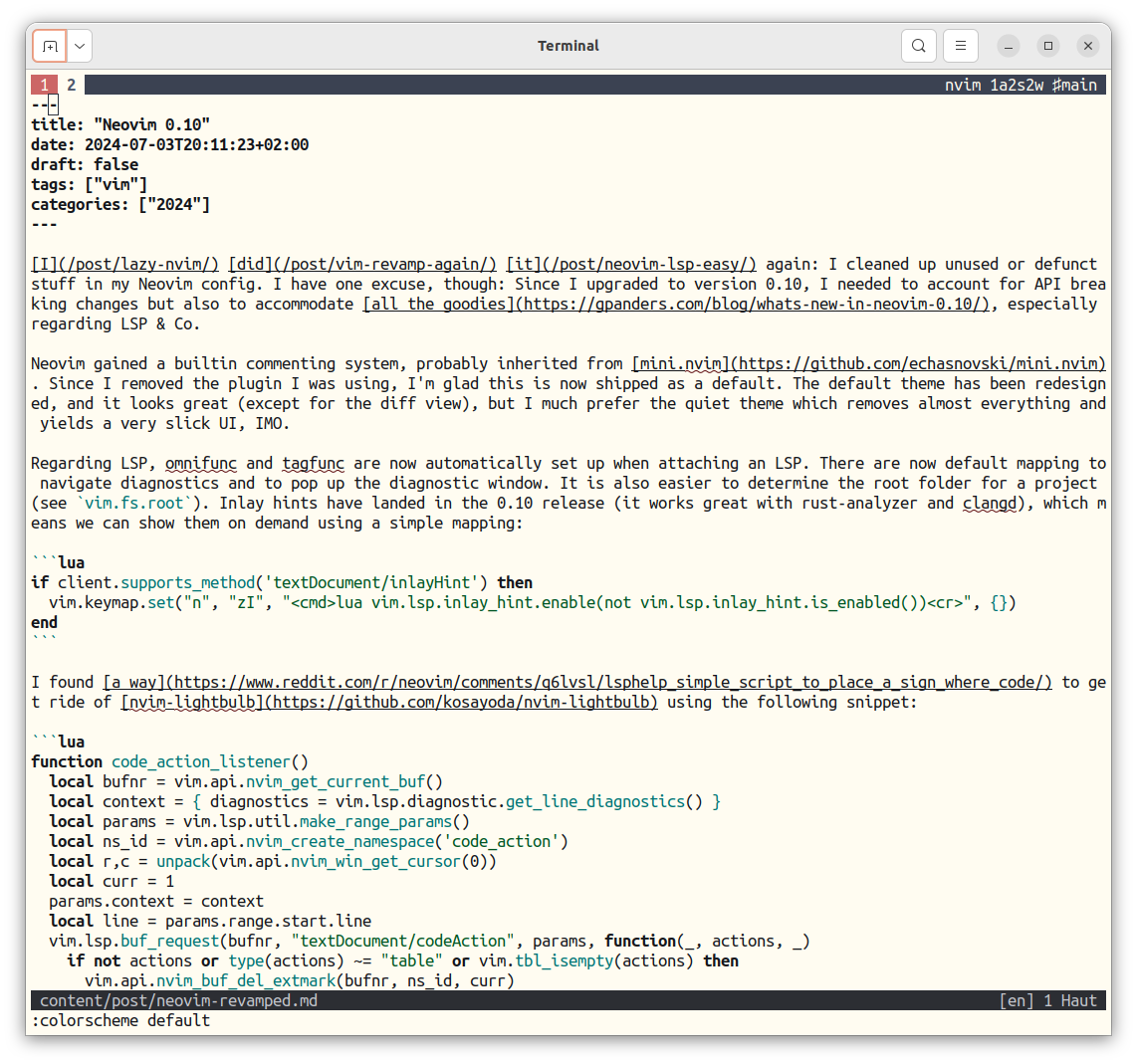Neovim 0.10
I did it again: I cleaned up unused or defunct stuff in my Neovim config. I have one excuse, though: Since I upgraded to version 0.10, I needed to account for API breaking changes but also to accommodate all the goodies, especially regarding LSP & Co.
Neovim gained a builtin commenting system, probably inherited from mini.nvim. Since I removed the plugin I was using, I’m glad this is now shipped as a default. The default theme (on the right below) has been redesigned, and it looks great (except for the diff view), but I much prefer the quiet theme (on the left) which removes almost everything and yields a very slick UI, IMO. See :help dev_theme for more info on the design of the new colorscheme.
[2024-07-06]
If I ever change my mind, I could still rely on the default theme when I’m working on my local computer and switch to the quiet theme for remote sessions. Something like that, maybe:[^1]
vim.api.nvim_command([[
augroup updatecolorscheme
autocmd colorscheme * :hi normal guibg=NONE ctermbg=NONE |
hi! link QuickFixLine Visual
augroup END
]])
if vim.env.XDG_SESSION_TYPE == "wayland" then
vim.cmd.colorscheme("default")
local fzf_theme = "light"
else
vim.cmd.colorscheme("quiet")
local fzf_theme = "bw"
end
Regarding LSP, omnifunc and tagfunc are now automatically set up when attaching an LSP. There are now default mapping to navigate diagnostics and to pop up the diagnostic window. It is also easier to determine the root folder for a project (see vim.fs.root). Inlay hints have landed in the 0.10 release (it works great with rust-analyzer and clangd), which means we can show them on demand using a simple mapping:
if client.supports_method('textDocument/inlayHint') then
vim.keymap.set("n", "zI", "<cmd>lua vim.lsp.inlay_hint.enable(not vim.lsp.inlay_hint.is_enabled())<cr>", {})
end
I found a way to get ride of nvim-lightbulb using the following snippet:
function code_action_listener()
local bufnr = vim.api.nvim_get_current_buf()
local context = { diagnostics = vim.lsp.diagnostic.get_line_diagnostics() }
local params = vim.lsp.util.make_range_params()
local ns_id = vim.api.nvim_create_namespace('code_action')
local r,c = unpack(vim.api.nvim_win_get_cursor(0))
local curr = 1
params.context = context
local line = params.range.start.line
vim.lsp.buf_request(bufnr, "textDocument/codeAction", params, function(_, actions, _)
if not actions or type(actions) ~= "table" or vim.tbl_isempty(actions) then
vim.api.nvim_buf_del_extmark(bufnr, ns_id, curr)
else
vim.api.nvim_buf_del_extmark(bufnr, ns_id, curr)
vim.api.nvim_buf_set_extmark(bufnr, ns_id, line, -1,
{id = curr, virt_text = {{"░", "DiagnosticInfo"}}, virt_text_pos = "eol"})
end
end)
end
if client.server_capabilities.codeActionProvider then
vim.api.nvim_create_autocmd({"CursorHold", "CursorHoldI"}, {
group = vim.api.nvim_create_augroup("code_action_sign", { clear = true }),
callback = function()
code_action_listener()
end,
})
vim.keymap.set("n", "z=", "<cmd>lua require('fzf-lua').lsp_code_actions({ previewer = 'codeaction' })<cr>")
end
This is all great news from people who like to keep their editor free of any IDE fancy things. There’s an interesting thread on HN regarding all those goodies.
As an aside, following my recent post, I briefly tried to get used to Conjure but I couldn’t find my way with the log buffer. The thing that I will probably miss is the ability to set marks and reevaluate them at will. But to be honest, I reverted back to molten-nvim which provides the best compromise between inline evaluation and my full REPL driven (with a terminal opened in a split) workflow. And I like the idea that I can plot almost anything in R, Stata or Python (with plotnine) and get a nice PDF almost instantaneously.
In passing, I also reworked my whole after/ftplugin/markdown.vim settings. Treesitter now handles most the stuff I implemented myself, especially navigating between section, folding, or block selection. I still need this stuff for org.vim since I removed the orgmode plugin so nothing’s lost. I added one package, vim-table-mode, which I used to use occasionally in the past.
♪ ANOHNI and the Johnsons • Epilepsy is Dancing
[^1]: Further improvement to the quiet theme would be to remove diagnostic colors altogether:
```lua
hi DiagnosticUnderlineError guisp=Black |
hi DiagnosticUnderlineWarn guisp=Black |
hi DiagnosticUnderlineHint guisp=Black |
hi DiagnosticUnderlineInfo guisp=Black |
hi! link DiagnosticFloatingError NormalFloat |
hi! link DiagnosticFloatingWarn NormalFloat |
hi! link DiagnosticFloatingHint NormalFloat |
hi! link DiagnosticFloatingInfo NormalFloat |
hi! link DiagnosticFloatingOk NormalFloat
```

